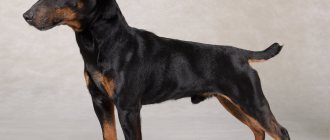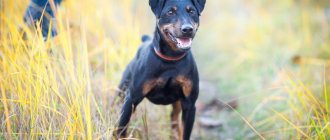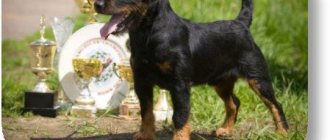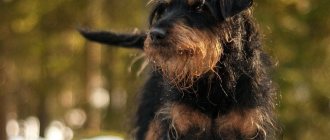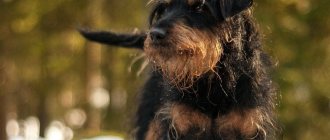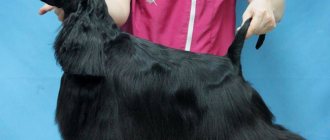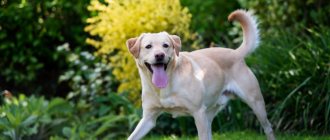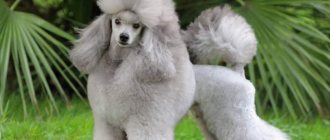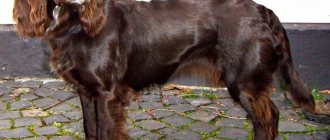The Jagdterrier is a German hunting terrier, a burrowing breed of dog.
An excellent watchdog, companion for a hunter and a very active person.
Brought out in the 19th century in Germany, it was quite difficult to achieve the desired qualities.
The goal of the breeders was to create a universal hunting dog with a dark color.
To breed the Jagdterrier and obtain the necessary hunting qualities, different breeds were used, such as the German hound, Lakeland terrier. pinscher dachshund and fox terrier.
Considering that the main task was to breed a working breed, the appearance - exterior - was not strictly taken into account.
There are two types:
The quality of a breed is mainly determined by the quality of its performance. In this regard, it must be at a high level. This is a type of burrowing hunting dog.
Most often she is taken to hunt fox, wild boar, hare, badger, and waterfowl.
It is very popular in Austria and Germany.
Jagdterrier content
In the photo there are Jagdterrier puppies on a lounger
A country house with a spacious enclosure would be ideal for keeping a Jagdterrier. This is an active and lively dog, which definitely requires a lot of long walks, even when kept in an enclosure. During walks, it is advisable to load the Jagdterrier with active games, long runs, and training.
The breed is smart and quick-witted, and quite quickly begins to understand the owner and follow his commands. It is very good to use the imitation method. If possible and desired, an adult trained dog should be nearby, then the Jagd Terrier begins to follow its example.
During training, he should feel that the owner is dominant. Rigidity cannot be used in training, but at the same time, instructions must be firm, precise and persistent. If the Jagdterrier doesn’t like the training methods, she will show it and be stubborn and disobedient.
With improper and cruel upbringing, the dog can become uncontrollable or too aggressive, therefore, great attention should be paid to training. If the upbringing is correct, the Jagdterrier becomes a very loyal, friendly and obedient pet.
When keeping a Jagd Terrier in a city apartment, the owner must take into account all the needs and disadvantages of the breed:
- Be sure to take a walk, 2 times a day, 1 – 2 hours.
- Moving, active walks with elements of training
- Don't let him off the leash; he might throw himself in front of a car.
- Hunt all living things for the rest of your life, get ready for unpleasant surprises (attacks cats, birds, strange dogs)
- May run away from home, or on a walk
- Left alone at home for a long time, he can damage property (chew slippers, toys, wires, etc.)
- Don't feed before going for a walk
- Work out on the playground, attend frisbee and agility training
Jagdterrier food, menu for a puppy
In the photo there is a Jagdterrier puppy with a stick
You can feed your Jagdterrier with dry professional food or natural food. If this is the second option, then it is necessary that the diet should be dominated by porridge, meat, and vegetables. Be sure to have clean water available for drinking.
Products necessary in the Jagd Terrier's diet:
- Beef, beef broth (it’s better not to give veal, it’s difficult to digest and can cause diarrhea)
- Various offal, chicken, turkey, beef
- Dairy products:
- low-fat cottage cheese up to 9% fat, otherwise give your pet a liver)
- kefir
- natural yoghurt, no dyes
- curdled milk
- puppies up to 3 months, milk
Porridge: buckwheat, millet, rice (for diarrhea), oatmeal Cartilage as a delicacy Seasonal vegetables and fruits
Jagdterrier: feeding a puppy
Menu for a Jagd Terrier puppy, feeding time and frequency:
Puppy 1 – 2.5 months:
- 8 o'clock – milk with curdled milk and a little honey
- 11 o'clock – rolled oats, pre-soaked overnight in milk, kefir, broth
- 2 p.m. – raw beef scalded with boiling water, boiled sea fish with raw vegetables, finely grated carrots, with vegetable, sunflower, soybean, or corn oil
- 17 o'clock – low-fat cottage cheese, or milk with honey (1 teaspoon per glass, can be with rolled oats, buckwheat)
- 20 o'clock – main feeding: raw meat, scalded with boiling water, with the addition of 0.5 teaspoons of vegetable oil. Chopped seaweed, half a teaspoon of finely chopped seasonal greens: lettuce, parsley, celery, dandelion leaves, young nettle, wild mint.
- twice a week yolk, dip raw meat into it.
- add garlic to meat and broth 2 times a week
Jagdterrier puppy 2.5 – 4 months:
- Feeding hours are 8, 12, 16 and 20 hours.
- Be sure to give meat and fish in the last two feedings
- Distribute milk, kefir, cereals and vegetables between morning and afternoon feedings.
- Increase the amount of meat additives to 1 - 1.5 teaspoons, depending on the weight of the dog.
A puppy older than 4 months of age is fed three times a day: at 8, 14 and 20 o'clock. Increase the amount of food and give meat with additives in the last – main feeding.
Feed a puppy after 8 months and an adult dog 2 times a day.
- In the morning cottage cheese, porridge, vegetables
- In the evening, meat or fish with additives
Interesting facts from the life of dogs
- When the first representatives of Jagdterriers were bred, most of the individuals were rejected due to inconsistency in color. Breeders wanted to achieve a pure black coat color. Due to superstition, two- and three-colored individuals were considered to bring bad luck.
- At the beginning of the twentieth century, the terrier was called the “German devil” for its ferocious character and ability to pursue game to the very end.
- The dog is in excellent health despite the artificial breeding of the breed.
- Without training, street dogs become aggressive and dangerous to people.
- The speed of pursuit of an animal is higher for yagterriers than for greyhounds.
- Despite the small size of the animal, they even go after bears with it.
Care and maintenance
Living conditions are not particularly important for the Jagdterrier - at home, outside in winter in an insulated enclosure, in an apartment: they are ready for any conditions. But there is still one limitation in keeping a Jagdterrier: the hunter needs hunting and physical activity.
What to feed a Jagdterrier
Everything that the owner gave goes “into the furnace” of the Jagdterrier. The dog doesn’t really look at the contents of the bowl: it smells edible, and that’s okay. The hunting breed requires a lot of calories and fat, so the diet is prepared accordingly.
You can also feed your Jagdterrier dry food – no less than premium food. The dog will not object, and such food maintains a balance of substances necessary for health.
The natural diet of the breed requires calories. Jagdterrier puppies are given both boiled eggs and fresh milk, but adults can do without such excesses. The diet of an adult Jagdterrier includes:
- stringy meat;
- offal;
- buckwheat, oatmeal, rice, millet cereals;
- fish fillet;
- fermented milk products with reduced fat content;
- vegetables;
- rendered beef or fish oil.
Both flat bones and cartilage will be useful for Jagdterriers. They help remove plaque from your dog's teeth and provide the body with the collagen it needs.
Prohibited for use:
- veal;
- semolina;
- River fish;
- pork;
- legumes;
- flour and sweet;
- salted and smoked.
When feeding your dog naturally, you cannot neglect the complexes of vitamins and minerals. It is better to discuss the specific course with your veterinarian after examination.
The frequency of feeding varies depending on the age of the Jagd Terrier:
- up to 2.5 months – 5 times a day;
- from 2.5 to 4 months – 4 times a day;
- from 4 to 8 months – 3 times a day;
- further - 2 times a day.
Walk
Jagdterriers need long walks - at least three hours a day. Activity is essential to maintain your dog's health and nervous system.
The dog will be happy to overcome obstacles, run, and jump. But where other people or animals may meet, you cannot let the Jagdterrier off the leash: he may react negatively to a person, get into a fight with a dog, or start hunting for other animals.
Grooming
The Jagdterrier is not demanding of care: it does not need professional groomers. There are differences in caring for animals with smooth and hard hair:
- For smooth-haired dogs of this breed, a rubber mitten or brush is enough to get rid of dead hair and massage the skin - twice a week is enough. During the shedding period, you will have to brush it daily.
- Wire-haired Jagdterriers require more attention: working dogs are trimmed, hygienically trimmed under the tail and between the toes, and the beard is shortened. The standard prohibits both trimming and cutting the Jagdterrier, but this only applies to show animals.
Hygiene
Jagdterriers do not really need water treatments - they are washed only when necessary, using shampoo for the desired coat type. The dog itself will not miss the opportunity to plunge into an open body of water, but you will have to make sure that no one is in the bathing area.
The Jagdterrier's eyes need to be cleaned every two weeks - with a cotton swab with chamomile infusion or drinking tea.
The ears of these dogs will have to be examined once a week, and cleaned as necessary, using a cotton swab with a special lotion.
The claws of representatives of the breed are trimmed once a month. The fifth toes on the front paws require attention - they are shorter than the others, and the claws do not grind down on their own.
A dog that takes part in hunting needs treatment for parasites and insects.
Mating
According to the regulations on breeding work published on the website of the Russian Cynological Federation, completely healthy individuals who have reached the age of 18 months are allowed to breed. In females, this is usually the third estrus.
A prerequisite for mating is to meet a male on the territory; females often behave aggressively on their reservation.
Mating is prescribed on days 9–14 of estrus; depending on the characteristics of the body, ovulation does not occur on a specific day. To obtain reliable information about readiness for mating, it is recommended to take a special ovulation test (the male is ready for mating all year round). Before mating, both individuals need to be treated against parasites and vaccinated.
Pros and cons of the breed
This breed is suitable only for energetic people who prefer an active lifestyle and know about the rules of care and the nuances of raising German hunters.
| Advantages | Flaws |
| Tireless fighter and fearless hunter | Aggression towards other animals |
| Miniature sizes allow you to feel confident in burrows | Explosive character |
| There is no innate predisposition to common diseases in dogs | Difficulty of training |
| High endurance and indifference to weather conditions | Will chew on everything it can reach if the necessary physical activity is not provided |
| Furious pursuit of the beast to the end | |
| Unique devotion to the owner | |
| Can make independent decisions | |
| Excellent makings of a born guard |
This freedom-loving dog breed is truly happy only during the hunt, where it can use the skills that nature has endowed it with.
In a family where there are no avid hunters, the Jagd Terrier may behave inappropriately. Even constant walks for several hours will not be able to release all the energy that exists within this tireless pursuer of prey.
If the dog’s owner is ready to devote all his free time to his beloved pet, to take him to a site specially equipped for burrowing breeds, where all conditions are as close as possible to real hunting, then the Jagdterrier will feel good in a city apartment.
Answer
The German Jagd Terrier is one of the healthiest dog species in the world. If the dog shows signs of illness, this is a result of improper care and nutrition, lack of communication and attention from the owner.
Dogs are required to take preventive measures to prevent helminthiasis. The animal is able to come into contact with other infected pets. Deworming is a necessary condition for a healthy lifestyle and well-being of the Jagd Terrier. It is recommended to carefully monitor the vaccination calendar. Vaccination against rabies is recognized as mandatory in accordance with current legislation.
If your pet becomes sad, inactive and clumsy, it is necessary to conduct a full examination by a doctor in order to promptly recognize and prevent a serious pathology. The doctor will order an examination, establish an accurate diagnosis and prescribe effective and safe treatment for your pet.
Regular examination in a veterinary clinic is considered correct.
What to feed?
On the one hand, the Jagdterrier is unpretentious in everything, including food, on the other hand, a hunting dog must always be in shape and in full combat readiness, and therefore the owner himself is interested in feeding his pet with the highest quality possible. As is the case with representatives of any other breeds, you can create an animal’s diet from both factory-made dry food and independently selected products.
With dry food everything is clear - the recommendations are the same for all dogs. The higher the class of the product, the better, and although premium and super-premium cost a lot of money, it’s not worth saving on the health of a dog risking its life in a fight with wild animals. Experts point out that certified products are not only completely safe for the pet’s body, but also contain all the necessary vitamins and minerals. At the same time, dry food contains practically no water, which means that for its complete absorption the animal must have constant access to drinking water.
If you decide to refuse the services of factory manufacturers and are ready to create your own diet for your dog, please note that all products must be fresh. You should not give your dog yesterday's food - be prepared to cook it again every time.
The list of permitted and required ingredients must include the following products.
Meat. This component is fundamentally important for any predator, and doubly important for the Jagdterrier, because these are proteins responsible for building muscle mass. It is meat that makes the dog strong and capable of defeating any enemy in close combat. At the same time, the dog’s digestive system is not always ready to digest excessively fatty foods, which is why pork or lamb is undesirable. It is better to focus on chicken, beef and turkey.
As is the case with the vast majority of breeds, it is forbidden to feed the Jagdterrier food from the human table - the dog’s digestive system is structured fundamentally differently and cannot cope with such a challenge. Sweet, hot, spicy and fatty foods, as well as smoked meats and baked goods, will be completely unnecessary on her menu. By feeding your pet such unsuitable foods, you risk being left without a faithful hunting assistant for a day or two.
The feeding regimen of an animal depends on what stage of life it is at. So, babies consume very little food at a time, however, they need to be fed at least four times a day. In most cases, two meals a day will be enough for an adult, but exceptions should be made for pregnant and lactating bitches - their body requires an increased amount of energy and nutrients, so three meals a day are provided for them. In the latter case, experts also recommend introducing tableted vitamins, which are sold at any veterinary pharmacy, into the menu as a separate item.
Like many other dog breeds, Jagdterriers do not understand when to stop eating - the predator cannot be sure that the next prey will be soon, so it eats to its fullest while there is such an opportunity. In the wild, this would hardly harm the dog, but when kept at home, an enthusiastic owner can easily feed the pet into a fat and clumsy carcass, which will no longer be of any use during the hunt.
You usually have to calculate the dosage of food by eye, but keep in mind that in winter, individuals who permanently live in open enclosures need to increase portions - they can only fight the cold with additional calories. Experienced dog breeders indicate that if there is clean snow, it is better to give it instead of water.
Description
The public received the German Jagderier warmly, inviting breeders to participate in exhibitions and present their work for public viewing. The pet had not only the characteristics of a hunter, but also an attractive appearance and small size.
No matter how serious a dog is, it is a favorite for many owners not only for its tracker qualities, but also simply because any animal gives joy with its childishness.
The appearance of the pet varies slightly, which allows some species to be presented on the pillow, and others - only as serious hunters, while the height and weight of both must correspond to generally accepted standards in both cases.
In the first option, no matter how trained the dog is, the main thing is its color, length of fur and other visual advantages. Hunters prefer an option that is less picky about grooming - short, coarse hair, minimal height so that the dog can easily climb into a hole and the absence of white spots; this nuance makes the game nervous.
According to their purpose, Jagdterriers are divided into the following types:
- official;
- fighting;
- decorative;
- sentinels;
- hunting
Features of behavior
As befits a real hunter, the Jagdterrier is distinguished by exceptional energy. This is a dog who never sits still. And if the energy is not directed in a peaceful direction, the child begins to look for things to do on his own - chewing furniture, digging holes, chasing cats. It is absolutely not suitable for lazy and melancholy people, but in hunting or sports the breed has no equal.
To this day, the Jagdterrier has retained amazing working qualities. This dog has an excellent sense of smell, endurance and a desire to work, thanks to which the breed is gradually moving from a burrow hunter into the category of universal hunters. Yagi are capable of hunting small burrow predators, swamp and steppe game, and ungulates with equal success.
The German Hunting Terrier cannot be called a dog with high communication skills. The breed does not get along well with other animals (especially rodents or birds); due to its innate leadership qualities, the dog can start fights on the street with other dogs. Treats strangers with caution, but without excessive aggression. Although with a good level of early socialization this deficiency can be reduced, it cannot be completely eradicated.
Another feature of the breed is courage, absolute and sometimes reckless. When going out to fight a predator, or defending a dog’s owner, the instinct of self-preservation is completely turned off. Which is fraught with injury, since the Jagdterrier’s opponent’s size never stops him; he is ready to fight to the death with anyone.
The breed is not suitable for novice dog breeders; it has a complex character. During educational processes, a poorly motivated child often displays remarkable stubbornness and self-will. And with harsh correction methods, he may snap back. Hunting breeds that do not know how to show independence in real hunting conditions are doomed to death; in Jagdterriers it is this trait that complicates the educational process.
Advantages
The German Hunting Terrier has a lot of advantages:
- Intelligence and quick reaction;
- Irrepressible energy;
- Strength and endurance;
- Good hunting instinct;
- Excellent hearing and sense of smell;
- Courage;
- Ability to make independent decisions;
- Compact dimensions;
- Easy to care for;
- Good health;
- Good security qualities;
- Unpretentiousness in content.
All the advantages of this little dog cannot be included in one list.
Flaws
Of course, despite all the advantages of the breed, there are also disadvantages:
- Poor level of communication;
- Hyperactivity;
- Lack of self-preservation instinct;
- Difficulty in training;
- Stubbornness;
- Frequent injuries.
History of the origin of the species
The history of the breed is not shrouded in myths and legends, due to the relative youth of the species - Jagdterriers trace their gene pool from fox terriers rejected for color. In the 20s of the 20th century, exhibitions became fashionable, and the selection of fox terriers was aimed at the exterior, which significantly reduced the working qualities of the dogs.
To the defective fox terriers, Walter mixed the genetic codes of English wire-haired terriers, Welsh terriers and other dogs with first-class working qualities, relegating appearance to the background. In just 10 years, Zangenberg managed to get two hundred black and tan dogs of the same type, which he named the German Jagdterrier. But the International Canine Federation accepted the breed only in 1954.
Character of the Jagdterrier breed
The character of the Jagd Terrier cannot be called simple - it is a bold, undaunted and courageous dog, sometimes in fights with animals the Jagd becomes a victim of its own courage. This is why dogs often get injured and even die while hunting.
Not everyone can become the owner of the Jagdterrier dog breed. Often, future owners underestimate the character of the dog, and then cannot find an approach to it and pay for their frivolous attitude towards this breed. If not properly trained, the dog can become aggressive towards humans.
Jagdterriers are serious, strict and stern dogs, not always generous with affection. This dog is confident in its abilities and, having a strong character, can stand up for itself and demands respect. With proper upbringing, he becomes an equal member of the family - devoted, faithful, manageable and contactable, despite his inflexible character. The Jagdterrier often shows remarkable intelligence.
This dog is intended for versatile hunting use. The nervous system of Jagdterriers still needs selective improvement (this is one of the youngest breeds of burrowing dogs), but sporting and hunting indicators are already quite high today.
Health
Another advantage of this breed is ideal health. Dogs of this breed rarely get sick. More often they are injured or killed while hunting. Usually the disease is a consequence of insufficient care on the part of the owner.
A prerequisite for maintaining the health of your pet is regular prevention against helminths and fleas. Do not forget about regular vaccinations against various viral infections such as plague, rabies, etc.
It is enough to visit a veterinarian for preventive maintenance once every six months. But if the dog has changed in behavior, has become lethargic, and refuses to eat, then you need to urgently contact a specialist.
But generally, with proper care from their owners, Jagd Terriers live up to 15 years.
Features of character and temperament
Because of his explosive temperament, Yag is called “dynamite.” His character must be assessed both in terms of hunting qualities and his social adaptability. He is, first of all, an assistant to the owner on the hunt. Therefore, its hunting qualities, for which the breed was bred, should be considered first.
The best owner for a yag is a hunter. The characteristics of the Jagd Terrier breed can be expressed by several qualities:
- Fearlessness and tenacity in pursuing the beast;
- Independence;
- Absolute devotion to his master;
- Discipline and precision in completing the assigned task while hunting.
From an early age, jags show their extraordinary character. In describing the Jagdterrier breed, many breeders point to its personal characteristics. Aggression towards other animals is inherent in them at the genetic level and the owner of such a dog should always remember this. Jagd tries to become a leader not only among his own kind, but also among family members, including the owner. And if he is given slack, then it will become simply impossible to cope with a hunting dog that can use its teeth. Therefore, if you want to have an excellent hunter in the person of a Jagdterrier, you must keep in mind that in his upbringing he needs a firm hand and a stronger will than he himself has. A Jagd who recognizes his master and unquestioningly obeys him will become a family favorite, disciplined and adequate.
When introducing animals into the house, you need to know that there should no longer be other animals there. These dogs do not tolerate either cats or birds due to their very jealous attitude towards their own person, as well as due to a very developed hunting instinct.
Keeping a Jagdterrier as a watchdog is also risky. He is adequate in the role of a watchman until someone gets in his way, in his understanding - “game”. It could be a cat or someone else's dog, or even uninvited guests who showed up without an invitation.
This is the complex, quarrelsome character of this small, seemingly unremarkable Jagdterrier dog, the photo of which you see. Therefore, the most important thing for representatives of this breed is proper upbringing, giving them a lot of time and effort - physical and mental. Then they make both wonderful hunters and loyal friends. Maintenance and care
Jagdterriers are unpretentious to living conditions. Important points in caring for these dogs are careful grooming and prevention of helminth infestation. The fact is that Jagdterriers have to deal with wild animals that are infected with helminths and can transmit them to the dog. In addition, a hunting dog must be promptly vaccinated against dangerous infections.
Feeding
A proper diet is of great importance in the life of a Jagd Terrier. From it, food should be excluded from the master's table once and for all. Neither a puppy nor an adult dog should be given smoked, fatty or sweet food. They need a varied diet, with a complete set of all nutrients, vitamins and microelements. High-quality dry dog food is suitable for this purpose.
Until the age of 4 months, the puppy must be fed at least four times a day. The diet should include fresh meat, boiled fish, chicken eggs, dairy products and vegetables.
Upon reaching 9 months of age, you can switch to three meals a day. This age period is very important for the formation of a healthy adult animal. Therefore, a young dog needs fresh meat and additional minerals. Portions during this period must be increased, since active growth requires a lot of building material. Only by the age of one can a young Jagd Terrier be switched to two meals a day
It is important to remember that adequate, high-quality nutrition for a student is the key to his good health and stamina as a future hunter.
The most important component of proper maintenance of berries is their active lifestyle. They vitally need long, several hours a day walks with energetic games and running. Without fulfilling this condition, it is impossible to keep berries, since they develop behavioral problems with a lack of activity.
Coaching and training
In characterizing Jagdterriers, one cannot do without the issues of training and coaching. They begin at three months of age, when the puppy masters basic commands. More complex training related to hunting begins at 10 months. It is better to conduct classes by a canine specialist due to the complex nature of the pupil. Therefore, one should approach his upbringing with full responsibility and not give him any concessions, trying to muffle negative character traits and encourage his virtues.
Photos of puppies
Since the breed is absolutely not commercial, prices for Jagd Terrier puppies are quite affordable. For 25,000 - 35,000 rubles you can buy a worthy representative, in a professional nursery, from working parents. A puppy without documents costs from 5,000 rubles. But without a pedigree, cynological organizations do not recognize the breed and permission to hunt cannot be obtained.
It is better to buy a future pupil from a nursery that has good reviews. When getting acquainted with the litter, you need to pay attention to the living conditions and health status of the dogs. It’s good if the breeder has documents confirming the absence of genetic diseases.
Basic rules when choosing a Jagdterrier:
- It is unacceptable for small puppies (without vaccinations) to roam freely around the yard - there is an increased risk of contracting a helminthic infestation.
- No hernia in the navel area.
- Clean, shiny coat, without signs of bald patches, dandruff, or dermatitis.
- The puppy must be at least 6 weeks old when sold.
- Absence of all kinds of discharge from the ears, nose, eyes.
- Availability of a veterinary passport with notes on all events.
Upon visual inspection, the future owner of the puppy should not have the slightest doubt about the pet’s health (both physical and psychological).
In order to choose the right Jagd Terrier puppy, you must first of all pay attention to its parents.
Factors to consider when meeting your puppy's parents:
- Parents' appearance.
- Accommodations.
- Temperament.
- Health, including mental health.
- Working qualities.
- Participation in competitions and victories.
The puppy itself should be quite active. If he plays and tries to hunt while playing, then the puppy will be a good helper. If the puppy is calm, then there will be much fewer problems with him. You can also choose the one who suits you yourself - it will be the perfect blow.
It is also important to pay attention to the baby’s appearance. If the puppy is well-fed, this is a good sign. If the puppy (under the age of one year) is quite thin, this may mean that the breeder did not treat the baby for worms. In the future, this may turn into problems with the skeleton and it will be very difficult to return it to the desired position.
Character
Let us immediately note that jealousy and aggression towards almost all animals will most likely become the reason for not accepting friendly relations with the owner’s other pets. The German Jagdterrier hates almost all living things except people. His intolerance towards them is explained by long-term selection and the introduction of genes from aggressive dog breeds.
Such a dog faithfully serves a person, but will not interact with his other pets as equals. She is moderately self-centered, quite proud and prone to independence.
If other breeds of hunting dogs strive to catch game in order to please the owner, then this one does not. The Jagdterrier hunts to satisfy its bloodthirsty instinct. But this does not mean that it harms the prey. Such an animal is quite adequate and well suited for pair hunting.
Advice! If you want such a dog to be friends with the rest of your pets, you will have to introduce them as early as possible. Terrier puppies are very affectionate and friendly, therefore, make them friends with other animals from the first days of their socialization in the house.
It cannot be said that representatives of this breed are standards of friendliness. Their attitude towards strangers is wary and suspicious. They perceive every stranger walking nearby as a potential threat.
The German Jagdterrier knows no fear; they are always self-confident, cautious and, at the same time, purposeful. Such pets will have to be looked after regularly, otherwise they become unmanageable. Those who have never interacted with representatives of this breed before will probably find it very difficult to get along with an adult.
If a dog does not respect its owner, it will not obey him or follow the rules of behavior in the house. Early competent socialization will help prevent the formation of a complex animal character.
But it is a mistake to think that yagi are difficult to educate and train. They also have advantages. For example, such dogs adapt well and tolerate loneliness relatively calmly.
But in return she demands similar affection. Ignoring is very upsetting for the animal. In the absence of contact with household members, it becomes very sad. She needs to get their approval regularly. Loyalty is one of the basic traits of his character.
The German Jagd Terrier may briefly forget about its “working” functions when it is invited to active play. He loves to bring a stick or ball to his owner. He will also not refuse to have fun with the kids. By the way, he doesn’t like children who are not included in the dog’s “pack”.
What does a German Hunting Terrier look like?
The priority in the selection work was to breed a dog with ideal working qualities, so the result of selection was reflected in the animal’s exterior. A striking difference is the pronounced sexual dimorphism. A strong and muscular constitution is more typical for males. Females are small in size, their physique is more graceful. Their weight ranges from 7.5 to 8.5 kg. Males have a body weight of 9-10 kg. The height of the German Jagdterrier reaches 33-40 cm. Regarding the type of coat, representatives of the breed can be smooth or wire-haired.
Wirehaired
The coat of this type of yagd is denser, tougher and elongated. The guard coat forms decorations in the form of a beard and small fringes. This is an external difference from smooth-haired individuals. The wool is coarse and feels that way to the touch. The Wirehaired Jagdterrier looks disheveled in appearance. In addition to a tousled beard, the pet has elongated hair on its belly and paws. You can't help but notice the animal's charming eyebrows.
Smooth-haired
Unlike the previous type, smooth-haired jags have dense short hair. It has no undercoat and lies very close to the body. The fur is evenly distributed over the entire body of the animal. It is distinguished by a pronounced natural shine. Smooth-haired dogs look neater and smoother. The standard identifies an intermediate option - the brocken, which does not have completely smooth or hard hair.
Conditions of detention
Due to its small size, the Jagdterrier can live in an apartment or private house with a local area.
There are some nuances to keep in mind:
- when keeping a dog in an apartment, they buy a lot of toys and often take it for walks, letting it burn off its energy;
- When keeping in a private home, the dog’s favorite pastime is taken into account – digging.
Therefore, the foundation of the fence is made deep enough, and the plantings in the garden or vegetable garden are protected by a fence.
Coat cleaning and bathing are done as needed. The molting process does not cause much trouble, although during this period the pet is combed with a brush. The rest of the time it is combed once a week. Ears, eyes and teeth are periodically examined.
Distinctive features
Description of the German Jagdterrier breed:
- General form. A strong, compact dog with a slightly stretched format.
- Height. At the withers, males have 34–40 cm, females 33–39 cm, weight 8–10 kg and 7–9 kg, respectively.
- Head. Small, wedge-shaped, tapering towards the nose. The occipital protuberance and the transition from the forehead to the muzzle are poorly defined. The eyes are symmetrically located, the shape is close to almond-shaped, brown or dark brown in color. The ears are small, triangular with a crease in the cartilage, set high and close to each other.
- Muzzle. Narrow, nose black or brown, lips tightly fitting. Scissor bite, jaws strong, teeth tightly clenched.
- Neck. Dry, without dewlap, with pronounced muscles.
- Frame. Compact but muscular, lacking dampness. The stomach is tucked in, the back is straight and strong. The ribs protrude slightly, the chest is moderately wide, descending to the level of the elbows.
- Limbs. Straight, parallel, fingers closed. The thighs are strong, muscular, the hock joints are well defined.
- Tail. It is docked and 2/3 is left. Set on moderately, in an excited state the dog holds it above the level of the back.
- Coat and color. The coat is thick and dense, in two variations - wire-haired and smooth-haired. There is very little undercoat. Colors are black or brown and tan.
Sexual dimorphism is moderately expressed and is welcomed in exterior assessment.
Type of vaccine
Vaccines that protect animals from infectious and viral diseases are divided into 2 groups:
- monovalent
- complex.
The first ones promote stable immunity against a certain disease and reduce the heavy burden on the animal’s body.
Complex (polyvalent) drugs create immunity against several diseases simultaneously, since they contain a complex of antigens. Polyvalent drugs eliminate the need for several injections at once and reduce stress for the animal. Both types of vaccines have a prolonged (long) effect.
Reviews
Sergei: “We got two Jagdterriers to guard the country house. Although a small dog, she is angry with everyone who approaches the house, does not let anyone near her, and even barks at cats running along the fence. The downside is a lot of noise, it reacts to everything that moves.”
Dmitry: “We decided to take a young Jagdterrier hunting for the first time. They caught a mole, and the dog drove it so deep into the hole that they could barely pull it out by the tail to pick up the animal. The dog is smart and angry, but sometimes uncontrollable.”
Olga: “Since childhood, we raised a baby German terrier to guard the house. My daughter loves to walk with him, she is 12 years old. When they leave, I am calm for her. The dog loves her and protects her from everyone, even from cats and pigeons. He eats everything we give him, the main thing is not to feed him from the table, otherwise the dog starts to get impudent and howl.”
